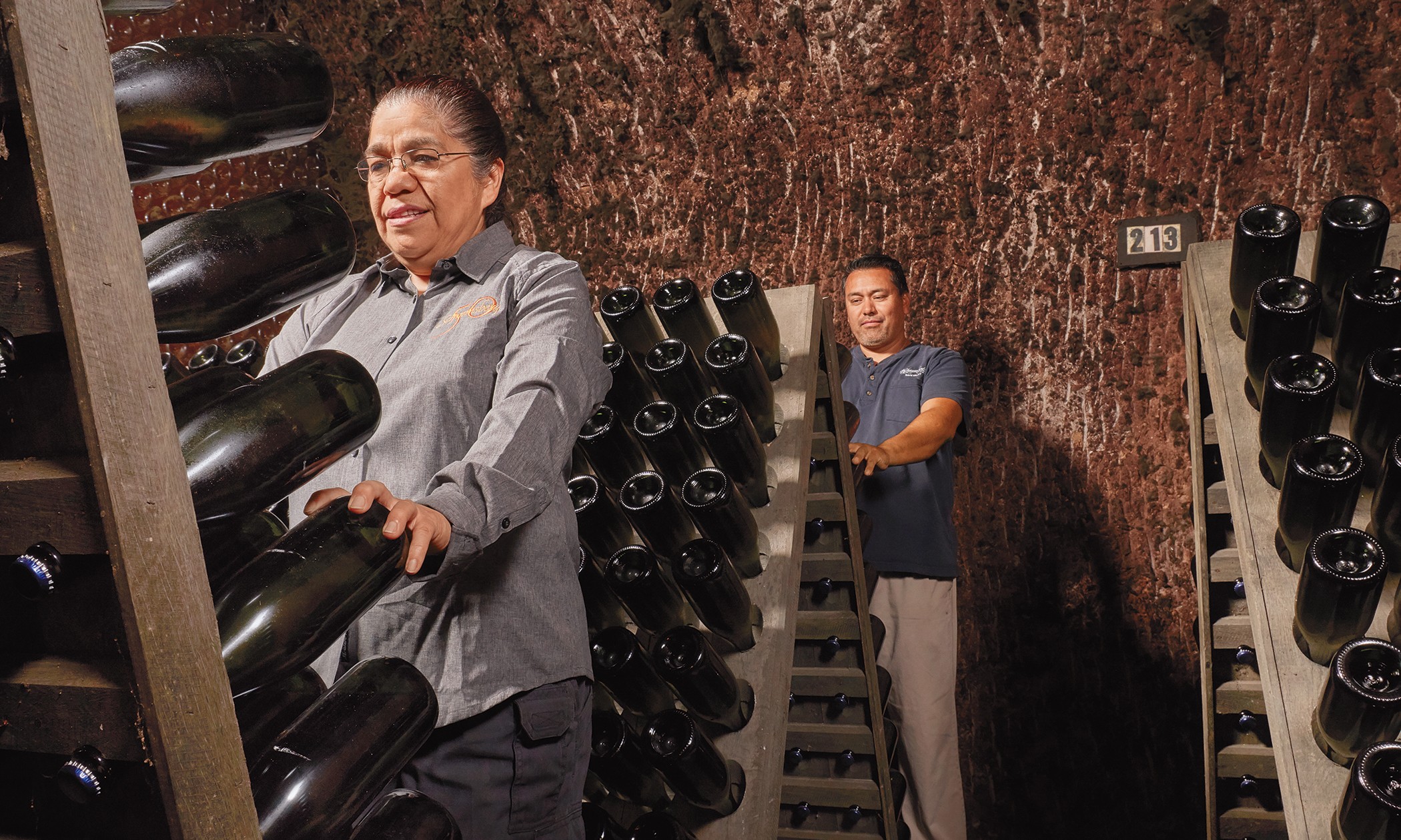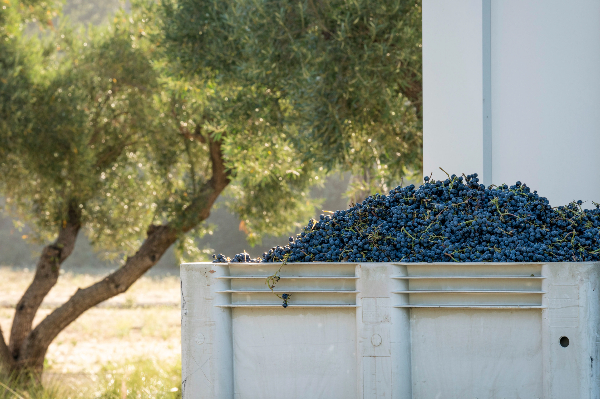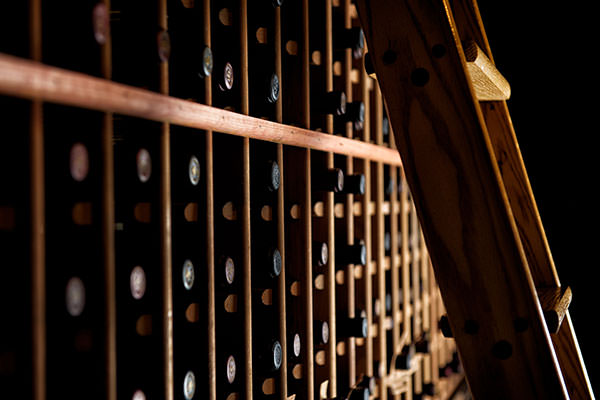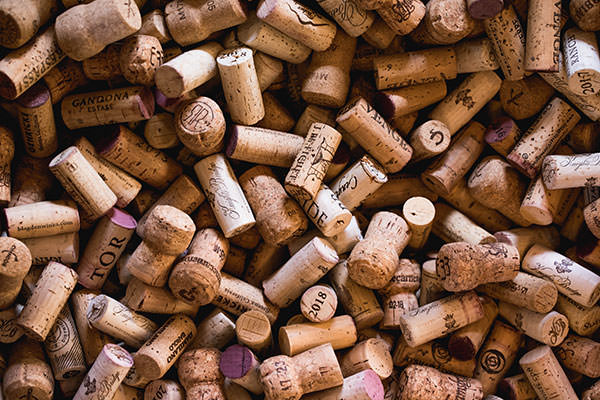There’s something alluring about a wine cave.
Perhaps it’s the notion of creating magic in a bottle out of sight from the outside world. Perhaps it’s the poetry of taking what the earth provides and going back to the earth to transform it into something wonderful. In today’s era of global warming and climate change, perhaps it’s simply the promise of operating sustainably, without taking too much from the environment around us.
Whatever the reason, winemakers have celebrated the spirit of innovation behind cave wineries for generations. Now, it seems, the trend is spreading across Napa Valley and beyond.
Take the new winery at Signorello Estate. The new digs (see what we did there?) are a nearly net-zero winery that comprises 12,000 square feet of underground space expected to be finished in early 2024. The cave system is so large Signorello Estate will be able to have most of the tasting room and all winemaking and wine storage operations underground.
Because air in the caves is naturally 60 degrees or below, the new facility will be able to all but eliminate heating and cooling expenditures, making Signorello Estate one of the most sustainable wineries in the valley.
“There’s no better way to store wine than in caves—this has been true for hundreds of years and it’s still true today,” says Ray Signorello, proprietor of Signorello Estate. “There’s something to be said for working with what the land provides and a cave enables you to do just that.”
Signorello Estate isn’t the only Napa Valley winery to invest in a cave system in recent history; Inglenook completed a 22,000-square-foot cave system in 2022 and Melka Estates should have a brand-new cave system ready for the 2024 harvest. Other notable Napa Valley caves include the circa-1870 caves at Schramsberg Vineyards and the Jarvis caves which include an entire underground waterfall.
Like the wine brands themselves, each of these cave systems boasts different features, details and vibes. As a group, the caves represent the next frontier of Napa Valley winemaking, and the latest trend in an industry-wide effort to consolidate facilities, reduce carbon footprints and craft wines more sustainably.
Why Caves Matter
Winemakers and vintners like caves for four basic reasons: temperature, humidity, darkness and safety.
Temperature is the most important. The wine industry considers anywhere from 55 to 60 degrees as the optimal temperature to store wine. Most caves register somewhere in the middle of this range.
Humidity is a big one, too. It minimizes evaporation inside wine barrels. The wine industry considers an average of 80 percent humidity to be optimal for barrel storage and wine aging. It turns out almost all Napa Valley wine caves have a natural humidity between 70 and 90 percent.
Darkness is a key as well, as wine ages better when it has minimal exposure to light.
Safety is a recent addition to this list. While a fire can take out surface facilities in hours, it likely would run over the top of a cave without harming much of anything inside. Caves are earthquake-proof, as well.
“Rock doesn’t burn or shake,” notes Jessica Koga, winemaker at Schramsberg Vineyards. “We’re trusting in Mother Nature to keep our product sound.”
Doing It for Decades
For these reasons, winegrowers and winemakers have been using caves to make and store wine for hundreds of years. The first caves in Napa Valley were built by Chinese laborers at Schramsberg Vineyards, in Calistoga. Another of the first cave systems in Napa Valley was the one at Beringer Vineyards, in St. Helena. A crew of Chinese laborers built these caves as well—reportedly by candlelight.
At Jarvis, in Napa, a 45,000-square-foot cave system completed in 1991 houses the entire winery, including crushing, fermentation, barrel storage, bottling, hospitality and more. The signature waterfall is also part of this complex.
More recently, the 10,000-square-foot cave system at CADE Estate Winery on Howell Mountain became part of a LEED Gold-certified winery that has won international awards for sustainable design. The caves go more than 100 feet into the earth and are used almost exclusively for barrel storage. “Everything about the caves fits really nicely with the sustainability aspect of our brand,” says CADE Winemaker Danielle Cyrot. “Everything we do, we do to reduce our footprint. Having wine aging in these cool, dark caves is nothing different.”
Form and Function
Napa Valley wine caves offer a balance of form and function, all underground.
All subterranean projects are designed by architects. The criteria for building caves are simple: 1) The site must incorporate a hillside; 2) The rock in the hillside should be soft, such as volcanic rock (as opposed to, say, granite); 3) There must be room for at least one entrance, or portal.
Building the cave itself is a complicated process that includes an excavator or giant conical drill bit not unlike the kind you might see in cartoons.
Caves are then waterproofed to prevent water seepage. Steel and shotcrete (essentially sprayed concrete) are added to provide reinforcement on the sides and a concrete floor is installed. Utility systems such as drains and heating, venting and air conditioning (HVAC) factor into the project, too—because temperatures in Napa Valley drop down to an average of 50 or below each evening, many wineries perform a nightly “air exchange” where they use big fans to pull in outside air and circulate it throughout the caves. Interiors are finished to the specifications of each client.
Variations on a Theme
Though all modern wine caves are made in similar fashion, each is unique in its own way.
At Signorello Estate, against the Vaca Mountains in the Stags Leap District of Napa Valley, ownership started with a blank slate after the 2017 Atlas Fire destroyed the winery. As Ray Signorello explains it, the new facility starts with a hospitality and fermentation space above ground and seamlessly moves into subterranean storage for barrels and more.
At Inglenook, on the west side of the valley in Rutherford, the 20,000-square-foot cave houses the entire winery operation, and four main tunnels are in the shape of a baseball diamond. When the new facility opened in 2022, owner Francis Ford Coppola waxed poetic about the fact that the caves comprised 120 separate fermenters, enabling winemakers to keep each vineyard block separate until they are ready to blend.
Inglenook’s Associate Winemaker Jonathan Tyer says the diameter of the cave is large enough for a bottling truck to back in, and he added that guests can access the cave through a portal to the outside or a portal that connects to the main chateau.
The new cave system at Melka Estates in St. Helena won’t change anything about how co-owner and Winemaker Philippe Melka makes wine, but it will maximize space more so than if the Melkas built a new winery on the surface. Currently, Melka’s winery exists in a small facility with three rooms, which means Melka and his winemaking team spend every harvest on forklifts moving things around.
With the caves, co-owner Cherie Melka notes everything will be under one roof.
“Our cave tunnels are 90 feet long, which means we can lay everything out without having to move it again and again,” she says. “The caves will help to make us more sustainable and more efficient.”
Unearthing Value
Most wine caves result in a reduction in energy expenditure almost immediately.
Cherie Melka estimates that when the Melka Estates caves are completed, she and her husband, Philippe, should see a “serious” reduction in energy costs virtually overnight. Ray Signorello said he expects to see even greater savings from the new caves at his eponymous winery, where an array of solar panels can be engaged to power the in-cave HVAC systems that keep the temperature consistent at 55 degrees. These same solar panels essentially can run the new facility completely off-grid.
Other wineries calculate the value of their investments in wine caves differently. At Inglenook, the new caves have unearthed a bold new position in the marketplace—a celebration of a winemaking philosophy that emphasizes the unique characteristics of 120 different blocks. And at Schramsberg Vineyards, roughly 2.2 million bottles of sparkling wine aging in the caves are part of the attraction.
“The caves have been a part of our story from the very beginning,” says Koga. “They’ll be a part [of our story] for hundreds of years to come.”




